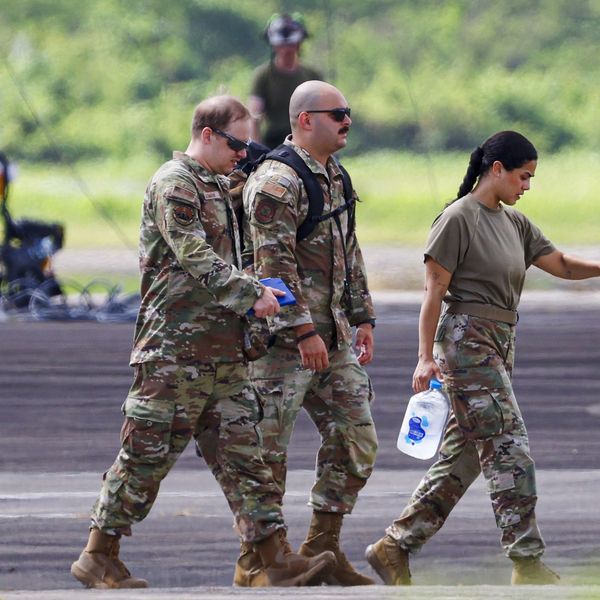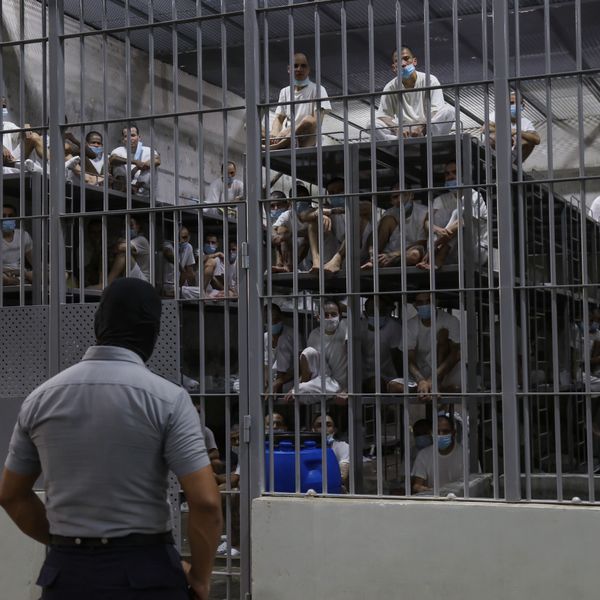Honduran Coup Shines Spotlight on Controversial U.S. Military Training School
Before the torture debates about Guantanamo Bay and Abu Ghraib, there
was the School of Americas -- a U.S. military training school in Fort
Benning, Georgia, which has trained some of the worst human rights
abusers in Latin America.
As Facing South reported yesterday,
two of the leaders of the Honduran coup -- General Romeo Vasquez
Velasquez, leader of the armed forces, and Gen. Luis Javier Prince
Suazo, head of the Air Force which transported the president to Costa
Rica -- were trained at the Western Hemisphere Institute for Security
Cooperation, formerly known as the School of the Americas.
The
Honduran coup leaders are just two of over 60,000 Latin American
graduates of the school, which since 1984 has been headquartered at
Fort Benning, Georgia. The SOA Watch database lists 3,566 graduates of the school from Honduras alone.
As watchdog groups like School of Americas Watch have documented,
many of the school's trainees have been directly linked to death
squads, killings of clergy and other aid workers, kidnappings and other
gross violations of human rights.
The School of Americas/WHISC has also been linked to torture. In 1996, Dana Priest of The Washington Post broke the story about use of training manuals at the school that taught students many controversial techniques:
U.S. Army intelligence manuals used to train Latin American military
officers at an Army school from 1982 to 1991 advocated executions,
torture, blackmail and other forms of coercion against insurgents,
Pentagon documents released yesterday show.Used in courses at the U.S. Army's School of the Americas, the manual
says that to recruit and control informants, counterintelligence agents
could use "fear, payment of bounties for enemy dead, beatings, false
imprisonment, executions and the use of truth serum," according to a
secret Defense Department summary of the manuals compiled during a 1992
investigation of the instructional material and also released yesterday.
General Romeo Vasquez Velasquez, widely credited with spearheading this
week's military coup, appears to have been trained at SOA when torture
was part of the curriculum.
Torture
techniques were introduced at SOA after Vietnam, when the U.S. used
lessons from the counterinsurgency experience in that war to create
course materials for the school. The practice was halted under the Carter administration in 1976 due to human rights concerns -- the same year that General Vasquez first attended SOA.
The
second time General Vasquez was trained at SOA in 1986, the torture
techniques had been re-introduced into the school's lesson plans and
training manuals under the Reagan administration. An in internal
investigation, the DoD later concluded that the inclusion of torture
techniques in violation of international law was a mistake. An internal memo dated March 10, 1992 stated [pdf]:
It
is incredible that the use of the lesson plans since 1982, and the
manuals since 1987, evade the system of doctrinal controls.
And
who was Secretary of Defense when these warning signs about U.S.
involvement in torture practices in Latin America came to a head? Dick Cheney, whose leadership in national security policy as Vice President would bring torture back into the media spotlight.
We're
not aware of any evidence that General Vasquez was directly involved in
torture, and the Obama administration has strongly condemned the
military coup. But such history is an important backdrop to current
events, which are vividly remembered in Honduras.
An Urgent Message From Our Co-Founder
Dear Common Dreams reader, The U.S. is on a fast track to authoritarianism like nothing I've ever seen. Meanwhile, corporate news outlets are utterly capitulating to Trump, twisting their coverage to avoid drawing his ire while lining up to stuff cash in his pockets. That's why I believe that Common Dreams is doing the best and most consequential reporting that we've ever done. Our small but mighty team is a progressive reporting powerhouse, covering the news every day that the corporate media never will. Our mission has always been simple: To inform. To inspire. And to ignite change for the common good. Now here's the key piece that I want all our readers to understand: None of this would be possible without your financial support. That's not just some fundraising cliche. It's the absolute and literal truth. We don't accept corporate advertising and never will. We don't have a paywall because we don't think people should be blocked from critical news based on their ability to pay. Everything we do is funded by the donations of readers like you. Will you donate now to help power the nonprofit, independent reporting of Common Dreams? Thank you for being a vital member of our community. Together, we can keep independent journalism alive when it’s needed most. - Craig Brown, Co-founder |
Before the torture debates about Guantanamo Bay and Abu Ghraib, there
was the School of Americas -- a U.S. military training school in Fort
Benning, Georgia, which has trained some of the worst human rights
abusers in Latin America.
As Facing South reported yesterday,
two of the leaders of the Honduran coup -- General Romeo Vasquez
Velasquez, leader of the armed forces, and Gen. Luis Javier Prince
Suazo, head of the Air Force which transported the president to Costa
Rica -- were trained at the Western Hemisphere Institute for Security
Cooperation, formerly known as the School of the Americas.
The
Honduran coup leaders are just two of over 60,000 Latin American
graduates of the school, which since 1984 has been headquartered at
Fort Benning, Georgia. The SOA Watch database lists 3,566 graduates of the school from Honduras alone.
As watchdog groups like School of Americas Watch have documented,
many of the school's trainees have been directly linked to death
squads, killings of clergy and other aid workers, kidnappings and other
gross violations of human rights.
The School of Americas/WHISC has also been linked to torture. In 1996, Dana Priest of The Washington Post broke the story about use of training manuals at the school that taught students many controversial techniques:
U.S. Army intelligence manuals used to train Latin American military
officers at an Army school from 1982 to 1991 advocated executions,
torture, blackmail and other forms of coercion against insurgents,
Pentagon documents released yesterday show.Used in courses at the U.S. Army's School of the Americas, the manual
says that to recruit and control informants, counterintelligence agents
could use "fear, payment of bounties for enemy dead, beatings, false
imprisonment, executions and the use of truth serum," according to a
secret Defense Department summary of the manuals compiled during a 1992
investigation of the instructional material and also released yesterday.
General Romeo Vasquez Velasquez, widely credited with spearheading this
week's military coup, appears to have been trained at SOA when torture
was part of the curriculum.
Torture
techniques were introduced at SOA after Vietnam, when the U.S. used
lessons from the counterinsurgency experience in that war to create
course materials for the school. The practice was halted under the Carter administration in 1976 due to human rights concerns -- the same year that General Vasquez first attended SOA.
The
second time General Vasquez was trained at SOA in 1986, the torture
techniques had been re-introduced into the school's lesson plans and
training manuals under the Reagan administration. An in internal
investigation, the DoD later concluded that the inclusion of torture
techniques in violation of international law was a mistake. An internal memo dated March 10, 1992 stated [pdf]:
It
is incredible that the use of the lesson plans since 1982, and the
manuals since 1987, evade the system of doctrinal controls.
And
who was Secretary of Defense when these warning signs about U.S.
involvement in torture practices in Latin America came to a head? Dick Cheney, whose leadership in national security policy as Vice President would bring torture back into the media spotlight.
We're
not aware of any evidence that General Vasquez was directly involved in
torture, and the Obama administration has strongly condemned the
military coup. But such history is an important backdrop to current
events, which are vividly remembered in Honduras.
Before the torture debates about Guantanamo Bay and Abu Ghraib, there
was the School of Americas -- a U.S. military training school in Fort
Benning, Georgia, which has trained some of the worst human rights
abusers in Latin America.
As Facing South reported yesterday,
two of the leaders of the Honduran coup -- General Romeo Vasquez
Velasquez, leader of the armed forces, and Gen. Luis Javier Prince
Suazo, head of the Air Force which transported the president to Costa
Rica -- were trained at the Western Hemisphere Institute for Security
Cooperation, formerly known as the School of the Americas.
The
Honduran coup leaders are just two of over 60,000 Latin American
graduates of the school, which since 1984 has been headquartered at
Fort Benning, Georgia. The SOA Watch database lists 3,566 graduates of the school from Honduras alone.
As watchdog groups like School of Americas Watch have documented,
many of the school's trainees have been directly linked to death
squads, killings of clergy and other aid workers, kidnappings and other
gross violations of human rights.
The School of Americas/WHISC has also been linked to torture. In 1996, Dana Priest of The Washington Post broke the story about use of training manuals at the school that taught students many controversial techniques:
U.S. Army intelligence manuals used to train Latin American military
officers at an Army school from 1982 to 1991 advocated executions,
torture, blackmail and other forms of coercion against insurgents,
Pentagon documents released yesterday show.Used in courses at the U.S. Army's School of the Americas, the manual
says that to recruit and control informants, counterintelligence agents
could use "fear, payment of bounties for enemy dead, beatings, false
imprisonment, executions and the use of truth serum," according to a
secret Defense Department summary of the manuals compiled during a 1992
investigation of the instructional material and also released yesterday.
General Romeo Vasquez Velasquez, widely credited with spearheading this
week's military coup, appears to have been trained at SOA when torture
was part of the curriculum.
Torture
techniques were introduced at SOA after Vietnam, when the U.S. used
lessons from the counterinsurgency experience in that war to create
course materials for the school. The practice was halted under the Carter administration in 1976 due to human rights concerns -- the same year that General Vasquez first attended SOA.
The
second time General Vasquez was trained at SOA in 1986, the torture
techniques had been re-introduced into the school's lesson plans and
training manuals under the Reagan administration. An in internal
investigation, the DoD later concluded that the inclusion of torture
techniques in violation of international law was a mistake. An internal memo dated March 10, 1992 stated [pdf]:
It
is incredible that the use of the lesson plans since 1982, and the
manuals since 1987, evade the system of doctrinal controls.
And
who was Secretary of Defense when these warning signs about U.S.
involvement in torture practices in Latin America came to a head? Dick Cheney, whose leadership in national security policy as Vice President would bring torture back into the media spotlight.
We're
not aware of any evidence that General Vasquez was directly involved in
torture, and the Obama administration has strongly condemned the
military coup. But such history is an important backdrop to current
events, which are vividly remembered in Honduras.

